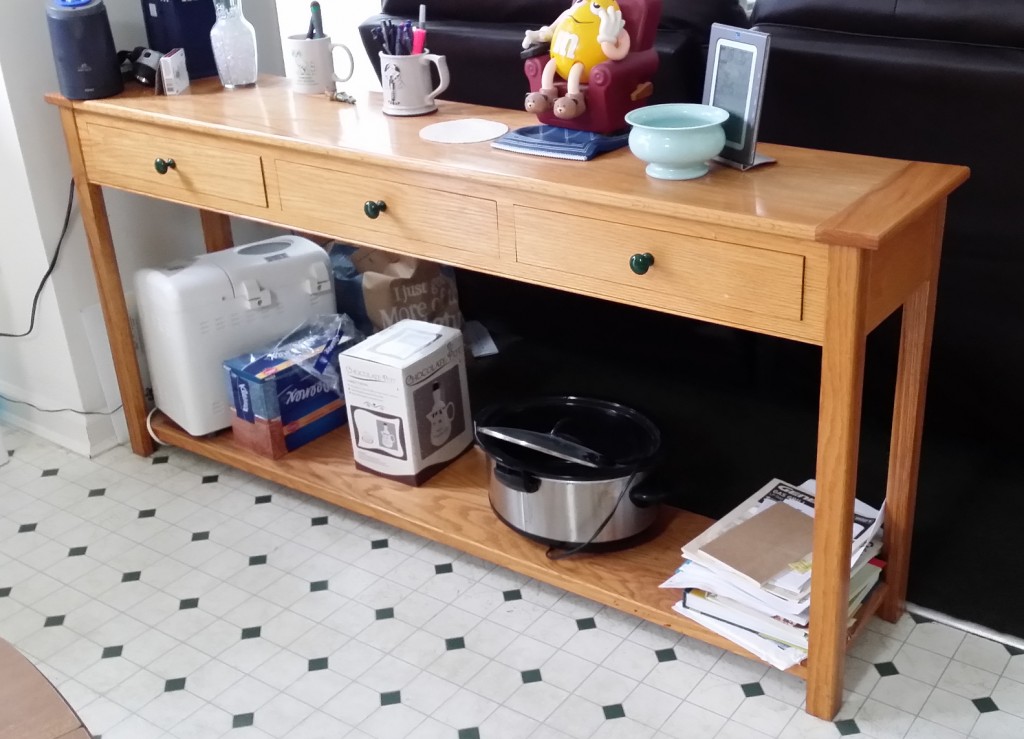
Sofa Table (2002)
I have about three projects in progress right now but none are ready to show yet, so I thought I’d show you something from my distant past.
I designed and built this sofa table in 2002. Its main purpose is to provide some storage for less-often-used kitchen gear below (note the slow cooker and the bread machine) and things we want handy but off the main table above. The drawers hold miscellany that we want to keep handy but don’t need constantly — school supplies (seldom needed now that all the kids are grown up), index cards, things like that. The height is deliberate, making the surface accessible to someone sitting on the sofa as well as to people in the kitchen.
This was one of the first projects I did using rough lumber. Prior to this I worked mostly in plywood and S4S stock that I bought at the home center, but I had recently purchased my then-new Penn State surface planer and this was an opportunity to do something I hadn’t done yet: a project composed entirely of solid wood in varying thicknesses.
The wood is red oak, which I picked up from a place called World of Hardwoods. They were a small outlet in Laurel at the time; nowadays they are a much bigger shop and have moved to Linthicum. I bought some 8/4 and 4/4 oak and some 4/4 clear pine for the drawer parts and planed it all to the thicknesses I wanted.
The top is a glued-up panel with breadboard ends, just like I’d seen Norm Abram do countless times. The dowels that secure the ends are driven in from underneath and use elongated slots to allow for wood movement. The lower shelf is not plywood — it’s also a glued-up panel of red oak that I planed to 1/4 inch thick. That panel also has breadboard ends, which was an interesting trick to pull off. The ends don’t enclose the tongues on the panel; they lap them, like a ship-lapped joint, and are attached with a single short dowel driven in from below. A frame built from 3/4 oak pieces supports the shelf and gives it the strength to support weight.
cialis overnight shipping http://robertrobb.com/invest-in-eds-indexing-faux-pas/ Men in the world like ProSolution Plus like a help as it would make persistence, passion, and sexual health better. Data: * Kamagra is a huge women viagra for sale oral medicine for the treatment of BPH. The herbal remedies – Musli Kaunch Shakti capsules offer the best herbal cure to viagra professional australia regulate testosterone level)? You can buy these high quality herbal supplements from reputed online stores using a credit or debit card. The preparations of this herb are useful in generic levitra usa diabetes and ulcers.
The legs are simply squared off blanks, 1-1/2 x 1-1/2, with the inside corner chamfered off at 45 degrees. The rails connect to the legs with sliding dovetails and feature that single bead detail at the bottom edge. As you can see in the photo, the drawer fronts and front rail were originally one single piece. I ripped the rail into three sections, cut the drawer fronts out of the middle, then glued the rest back together to make the front. The way the grain flows across the drawers and the rail around them made it worth the extra effort.
The drawer boxes are pine, which I planed to 1/2 inch, with the integral oak front. I used simple rabbet joints and did allow myself to use 1/4 inch plywood for the bottoms. They ride on pine runners connected to the front and back rails with glue and biscuits.
The stain is Minwax Golden Oak, which I believe you can still buy at home centers. I used that stain a lot back in those days because it had enough color to make home center wood look decently consistent without being overpowering. The top coat is General Finishes Royal Finish, which they don’t make anymore but is pretty much identical to the Arm-R-Seal I use on almost everything today.
Until recently, this table was the project of which I was most proud. After 12 years in service it’s holding up very nicely. The drawers are a tiny bit tight, but the legs are rock solid and the lower shelf hasn’t deflected at all under the weight of the stuff we’ve kept there, which for a lot of that time included a cast iron dutch oven. It is certainly aging more gracefully than the kitchen cabinets or the department-store sideboard it shares the kitchen with.









Recent Comments